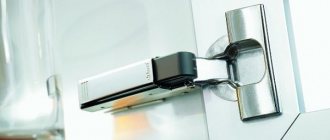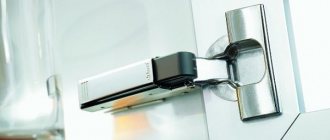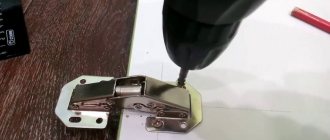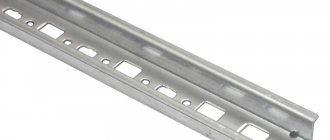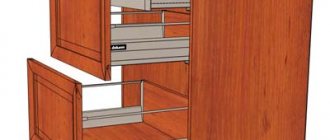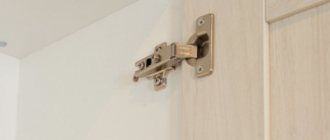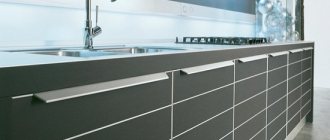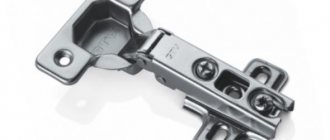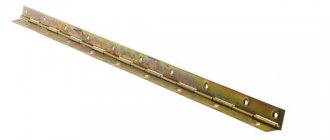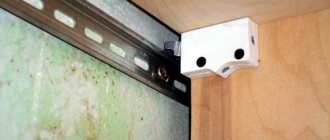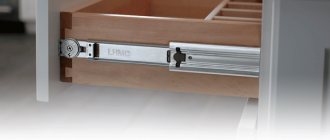When buying ready-made furniture or ordering it according to an individual design project, we are rarely interested in what type and quality of furniture hinges for opening facades are installed. However, how long the door will open without squeaking or sagging depends on which furniture hinges for the cabinets were initially chosen. It’s never too late to find out about this: at any period of operation, you can independently replace some hinges with others. At the same time, the costs will not be so high and a minimum set of hand tools will be required to install and adjust the hinges yourself.
Furniture hinges for cabinet doors: how to choose a model with a 45, 60 and 90 degree closer
In modern production, a large number of accessories are used. In this article we will look at furniture hinges for cabinets. These are mechanical devices for opening and closing swing doors. There are many different models sold in stores, and before purchasing, it is advisable to know which option will suit your facades. We will tell you about the design and installation features of canopies.
What to consider?
If suddenly, for some reason, a person needs to choose and buy hinges on his own, then this issue must be approached wisely. And you need to purchase only high-quality awnings, despite the fact that they all look the same on the display case. It is better to take those that are more expensive, but from a trusted manufacturer, than suspiciously cheap ones. Poor quality hinges can:
- quickly become loose and require constant adjustment;
- start creaking or closing poorly;
- break;
- start to rust.
How to choose furniture hinges
Important! It is worth refusing to buy Chinese hinges. These structures are very unreliable, as a rule, they collapse very quickly and cease to function. Low-quality alloys are used for their production. And China supplies defective hinges to our markets in very large quantities.
By installing cheap hinges, you can save money only in extremely rare cases. Typically, such structures require early replacement, which means additional costs and a waste of time for dismantling the old loop and installing a new one. The miser pays twice - a saying that is very true when it comes to furniture hinges.
How to choose furniture hinges
Hinge furniture hinge
The hinge is the familiar awning. The operating principle of the design is implemented using a connecting rod, which serves as a hinge during longitudinal sliding and provides a movable connection of two parts (cards) into a kinematic pair.
This type of fastening is used everywhere for furniture fittings. Their distinctive feature is that they are installed inside the furniture, preserving the aesthetics of the facade of the set. Progress here, too, is moving towards more complex designs - there are a lot of all kinds of modifications and improvements. I wouldn’t be surprised if in some fifty years “smart” hinges start going online, opening through a mobile app and dancing a little at the same time.
Types of furniture hinges
Science has not yet advanced that far and the structure of this object is quite simple. Depending on the method of fastening the door and the design, there are several types of furniture hinges.
- Upholstered furniture in Perm
- Beds with soft panels at the head: stylish solution and comfort
- Ideas for arranging furniture in a small room
Structural ones differ in the number of hinges. Among them:
- half-hinged - one component has a static pin, on which another, attached to the door, is placed on top, like a cap. The only fastening that allows you to remove the door without removing the hinges;
- single-hinged - several cards arranged in a checkerboard pattern are combined using one rod;
- four-hinged - the most common, popularly known as a frog, consist of a mounting plate (base), a movable mechanism (arm) of four hinges with a spring and a cup for which a recess is made in the thickness of the door.
- eight-hinged - used in cases where there is nowhere to cut a recess, for example, for glass or thin doors.
Note! How to glue boards for a tabletop?
According to the method of attaching the door to the furniture frame, the hinges are divided according to the type of location of the door leaf relative to the body:
- overhead or external - the door is located on top of the body, the moving mechanism is without bending;
- semi-overlay or middle - used when two doors are attached to the frame on both sides, each of which extends half the width of the frame;
- inset or internal - the door is recessed, the body borders it;
- corner – designed for corner furniture, provide opening at angles of 30°, 45°, 90°, 135° and 175°;
- adit or straight - fastening the facade to a false panel, or body, joint to joint, in one plane;
- inverse or rotary - allow you to open the door almost up to 180°, and can be external, middle and internal;
Hinges are also divided into additional subtypes: mezzanine for cabinets that open vertically upward; secretory for a door that folds down; card for folding tables in order to ensure a single plane and a lot of completely non-standard options for all occasions.
Work order
Marking is a very important step when installing hinges. It involves marking the door where the hole for the hinge bowl will be drilled. Moreover, it is important to first find the place where the center of the hole will be located. And here it is important to understand that the number of hinges directly depends on the size of the facade itself and its weight . But in any case, you need to retreat about 7-12 cm from the edge of the door. The distance between installed canopies should not be less than 50 cm, provided that several of them are attached.
Hinge Attachment
Table. Required number of loops.
| Options | Number of loops, pcs. |
| Length up to 1 m, weight – no more than 9 kg | 2 |
| Length 1-1.5 m, weight – up to 15 kg | 3 |
| Length up to 2 m, weight – up to 20 kg | 4 |
| Length 2-2.5, weight no more than 20 kg | 5 |
After marking, you will need to make holes for the hinges. They are performed using a special drill. It is best to place the door on a flat, hard surface, this will make it easier to work with. The depth of the recess should be approximately 1.2-1.3 cm. If you make it deeper, there is a risk of damage to the outside of the facade. And you need to drill the hole clearly vertically.
Diagram: loop fitting dimensions
Important! The cutter must be sharp and preferably new.
After drilling, you can install the hinges, and you will also need to adjust them. Only in this case will the door hang straight.
Calculation of the number of furniture hinges for installation
Installation process
- Determine the location of the furniture hinge cup. It usually has a standard size of 35 mm. The optimal distance from the free edge is from 80 to 120 mm. At this distance, we make an indentation from the edge of the end of 22-23 mm and mark it, making a small hole so that at a critical moment the drill does not slip from the intended point.
- Using a 35mm Forstner drill, drill a recess for the cup. Without fanaticism, so that the hole does not suddenly turn out through.
- Using self-tapping screws or other fasteners provided in the kit, we first fasten the hinge to the facade, then to the box forever. The design of modern furniture hinges provides adjusting screws that allow, without remembering someone’s mother, to adjust the tilt of the facade left and right, or up and down, if necessary.
How to prepare for installation?
Installing hinges is a simple job and does not require much effort and time, but provided that the person has all the necessary tools at hand and also has certain work skills. For those new to the project, the task of installing a hinge can be very challenging. You can't just screw it on.
So, the most important tool you will need is a Forstner drill . It has a special working part with the same diameter as the hinge bowl (35 or 26 mm). Using this drill, you need to make special holes in a clearly marked place. The hinge bowl will be inserted into it, and the structure will be secured using screws screwed into special ears.
Forstner drill
To install the hinges you will also need:
- screwdriver;
- ruler and square;
- a simple pencil;
- drill with various attachments;
- level;
- self-tapping screws and self-tapping screws.
Cordless screwdriver
It is important to take into account the material on which the loop will be fixed. Thus, fibrous or loose materials are quite soft, glass ones are fragile and at the same time strong, etc. Each material uses its own specific type of fasteners, and in different quantities.
Types of furniture hinges by design
There are many hinges and canopies used to attach a swing door to the frame of a cabinet or cabinet. Basically, in modern furniture production, four-hinged hinges , which allow the facade to be adjusted in three planes at once:
- higher lower,
- left/right,
- to/from the facade.
All of them consist of two interconnected parts - a bowl with an elbow and a strike plate . Often the strike plate is called a mounting or mounting plate. This article will focus specifically on four-hinged hinges.
Other types of furniture hinges can be combined into one large group as “bowlless” hinges.
piano hinges, card hinges, pin hinges, and heel hinges, known to everyone for fastening interior doors and facades in old furniture . They are rarely used in modern furniture. For example, piano, card and mortise hinges can be used to attach tabletops to the base, movable legs in book-tables. For ordinary cabinets, brass decorative hinges are used as additional decor.
- Is it possible to place a bed opposite the door?
- How to sell furniture active sales?
- Adhesive paper for furniture
Overhead hinges that do not require drilling of the facade . They come in handy when the thickness of the material chosen for the facade does not allow installing (embedding) a four-hinged hinge due to the depth of the bowl. The only drawback of such hinges is their rigid fastening, which does not allow adjustment in three planes, like four-hinge hinges.
Hinges for fastening specific facades . For example, prefabricated facades made of aluminum frames of different widths are installed on special hinges - you can purchase them together with the profile. Please note that, just like regular four-hinged hinges, they can be overhead or internal, designed for corner cabinets of 45, 135, 180 degrees and facades covering the end of the case.
Purpose of awnings with closers
Such fittings are widely used in furniture production today. Thanks to the self-closing design, the furniture will retain its appearance during long-term use and will become less susceptible to any damage.
The hinged door closer can be installed on a variety of furniture
Table 2. Designs that are most often equipped with self-closing hinges
| Furniture type | Description |
| Bedroom | It can be:
|
| Kitchen | This is furniture by type:
|
| For living room, children's room | Desks and various cabinets can be protected from damage. The child will be able to close the doors without slamming them. |
| Office | Often, hinges with a closer are equipped with:
|
| Trading | Often such fittings can be seen on glass display cases. Typically, glass cabinets and display cases are installed in commercial establishments to display goods. To install hinges to such furniture, additional frames made of aluminum profiles are used. It is not recommended to install hinges directly on the glass itself. You will have to make holes for the fittings, which is why the rather fragile material may lose its strength qualities. The metal frame will make the design more hopeful. |
Adjusting the location of the hinges does not cause difficulties even for a person who has never worked with furniture fittings
Types of four-hinged furniture hinges
According to the design, according to the way the bowl with the knee is attached to the striker, four-hinge furniture hinges can be of three types:
- Slide-on—the parts of the loop are inserted into each other and connected using a fixing screw that has special notches, thanks to which it reliably “holds” the connection even in a weakened state. This type of loop is the most common.
- Clip-on - the parts of the loop are connected by simple snapping, without screws. The facade can be removed and installed without using any tools - just pull the latch. Clip-on hinges are also called quick-installation hinges.
- Key-hole – on the shoulder of the bowl with a knee there is a hole resembling a key hole in shape - a keyhole. The arm and bar are secured by passing the head of the fixing screw through this hole.
Regardless of the design, all of the above types are divided according to their purpose and installation method - what facade is used in the furniture and how it is attached to the body.
90 degree hinges
*The designation 90 degrees in this case is conditional, it is used to mark hinges that open at a right angle. In fact, the door travel is somewhat greater, reaching about 105-120 degrees when opening. Some manufacturers and sellers of accessories may label this type not “loop 90”, but, for example, “loop 110” - there is no mistake here.
The 90 degree overhead (external) loop has a straight “shoulder”, without bending. Used for facades that completely cover the ends of the side walls of the body (without taking into account the technological gap, which can be 1-5 mm).
Half-overlay (middle, half-outer) loop 90 degrees , the shoulder of the bowl with the knee can be distinguished by a medium bend. Rarely used. For example, in kitchen two-row horizontal cabinets for attaching the bottom door and in three-leaf wardrobes for attaching the middle facade.
The 90-degree inset (internal) hinge is distinguished by a large bend on the “shoulder”, due to which the inset door is carried out when opened outside the body. Rarely used. For example, in office furniture, in which the body is made of thickened 22 mm chipboard and the internal facade emphasizes this detail.
180 degree hinges
A straight (gauge) hinge for false panels is designed for attaching the facade to the sidewall, which is located in the same plane. Most often used in corner kitchens, when using the appropriate corner sink module.
The 165-degree carousel (crab, crocodile, transformer) hinge is recognizable by the characteristic complex shape of the bowl's elbow, which ensures that the door opens completely relative to the body - almost up to 180 degrees. It can also be invoice, semi-invoice and inlay. Differs in the shape of the shoulder.
Types of corner hinges
A 30-degree corner hinge “presses” the façade, located at an angle of 90+30 degrees relative to the body. It is most often used in beveled end cabinets of kitchen units or wardrobes. Installation angle – 120 degrees. Some manufacturers mark it by installation angle, i.e. called a 120 degree loop.
The 45 degree corner hinge is used in trapezoidal single and double door cabinets - for example, kitchen or dressing rooms. Similar to the previous type, it can be called by the angle of installation - a 135 degree loop.
An angular loop of 120-135 degrees most often serves as a connection between two facades, fastened together at a right angle of 270 degrees, which come off like an accordion. In this case, the door without a handle is attached to the body using a carousel hinge from the previous category.
Note! How to care for a mattress so that it lasts a long time
Corner hinges with a negative opening angle are used extremely rarely, due to design features: end cabinets, as a rule, serve as the end of a row of furniture and it is more convenient to open the door from the other side. But there are projects in which it is more expedient to implement the opposite solution.
The photo shows the main types of standard furniture hinges, without closers , ensuring smooth closing. Hinges with closers are classified similarly - depending on the type of facade and the installation angle relative to the body. They differ in appearance from standard ones only in the shape of the shoulder, inside of which a special movement-absorbing mechanism is built. Also, the closer may not be built-in, but overhead - as, for example, a manufacturer such as Blum offers. But the bulk of offers on the market still do not imply the possibility of improvement. Therefore, if you are determined to install facades with soft closing, without annoying knocking, purchase fittings with closers right away. True, it costs a little more. Before purchasing, I recommend that you read the review on furniture hinges with closers.
A separate group of furniture hinges is for glass facades, with and without drilling glass. Review on glass hinges here.
Popular manufacturers of hinges with closers
In furniture stores you can see products of various brands. These can be both expensive and cheaper fittings options.
Table 1. The most popular brands of furniture hinges
| Brand | Description |
| Polish manufacturer of self-closing hinges. Fittings from this brand are widespread not only in Europe, but also in Asia. Hinges differ from GVS:
|
| Russian manufacturer of furniture fittings. For the manufacture of canopies with closers, high-quality materials are used. The manufacturer claims that its products are resistant to:
|
| Bloom | An Austrian manufacturer producing high quality fittings. The hinges are different:
|
| Hettich | A German furniture manufacturer that offers consumers a wide range of high-quality furniture hinges with various functionality. Hettich produces guides with a closer for quick and slide-on installation, with the possibility of spatial adjustment. Good reliability indicators are ensured:
|
| The Spanish manufacturer, which has been operating for more than 55 years, produces high-quality furniture fittings. INDAUX has its own development department, thanks to which the range of soft-close hinges is regularly updated. Manufactured parts comply with European standards - they constantly undergo quality checks. |
It is better to choose accessories only from proven popular manufacturers
Types and characteristics of furniture hinges, fastening rules
The wear resistance of cabinets, tables, bedside tables largely depends on the quality of the fittings. This is a huge category of products, including hundreds of varieties of products, from guides to confirmations. Furniture hinges are irreplaceable elements; they allow you to conveniently open the doors at a certain angle. A few years ago the choice of this additional equipment was small, but today the situation has changed. Accessories such as hinges are classified according to design, materials of manufacture, and installation method, so to select the correct elements you need to know many nuances.
- Basic characteristics
- Basic designs
- Cupless
- Overhead and semi-invoice
- Quadruple joint
- For specific facades
- Manufacturing materials and design
- Varieties according to installation method
- Tips for choosing
- How to attach and adjust
- Video
Assembly tools
When carrying out any furniture assembly, you must have a manual set of tools, an electric drill. The very first necessary device is a tape measure. For accurate markings, you will need a medium-hard pencil. Hexagon for single-element tie connection of parts. A screwdriver is an indispensable tool for drilling and screwing.
You can set a clear line at an angle using a square. An item that is very helpful when assembling furniture is a slanting knife. The immediate tool for installing fittings is a special drill for furniture hinges. Now, knowing the types and purposes of furniture hinges, as well as how to adjust furniture hinges, you will not have problems with selection and installation.
Basic characteristics
Furniture hinges are semi-mechanical devices for fastening the facade to the furniture body and making doors comfortable to use. Installation is carried out using self-tapping screws. The cup of the furniture hinge is fixed to the facade, and the mounting strip is fixed to the frame. There are several types of products depending on the opening angle:
- 45 degrees. Used for corner cabinets, trapezoid-shaped cabinets with one or two doors. This could be kitchen or wardrobe furniture.
- 90 degrees. Allows doors to be opened at right angles. There are several types of loops. Overlays do not require bending and are suitable for facades that completely cover the side walls. Semi-overlays have a medium twist, while internal ones have a large twist. The former are used in three-leaf wardrobes, the latter in office furniture.
- 165 degrees. Carousel loops are distinguished by the complex shape of the bowl elbow. Relevant for corner bedside tables.
- 180 degrees. Used for mounting false panels and connecting the facade to the sidewall. A popular option for kitchen sets.
- 270 degrees. Suitable for any folding door.
The selection of suitable hinges is based on the design features of the products. The purpose of the interior items must be taken into account. Other factors also matter: the intensity of use, the material from which the furniture is made.
How many hinges do you need to buy to securely install the door?
To install hinges on doors yourself, first of all, you need to determine the required number of devices. It depends on the dimensions and weight of the door being hung, as well as the material from which it is made.
How many pieces do you need to buy depending on the weight and height of the facade?
In order for the hinges to fully cope with their assigned task - to ensure the free opening/closing of doors without creaking or moving, they must be installed correctly. Usually, instructions are always attached to the product.
The video will also help you understand the installation principle:
Basic designs
Due to the rapid development of technology, the requirements for the design and production of interior items have increased. Accordingly, the range of modern furniture hinges has expanded. Today, products are divided into cupless, overhead, semi-overlay, and four-joint groups. There are also models for attaching non-standard facades.
Cupless
The classic design consists of two thin plates connected to each other. There are holes along the edges for screwing in self-tapping screws; the opening angle is 90 degrees. Such furniture fittings are divided into several types:
- Pianos. Mechanisms with one hinge act as hidden fasteners. They are used in cabinets, kitchen cabinets, poufs with a raised seat.
- Heel. Hinges consisting of a pair of strips. The main disadvantage of the models is their low load-bearing capacity. Relevant only for light facades.
- Card. The design is similar to their piano counterparts; the fasteners are fixed using holes located along the edges of the plates. There are various sizes of mechanisms. Scope of application: boxes, furniture in retro style.
- Pin. In appearance they resemble card loops, but special pins are used for installation, which can vary in length. For light structures, products with 2-3 fasteners are selected, for heavy ones - with 4 or more.
The heel loop, like other cupless options, is rarely used in furniture production today. These are mainly decorative items that complement folding table tops. The designs have also found application in the installation of interior doors.
Overhead and semi-invoice
Overlays are products that are mounted without drilling. Suitable for thin facades that do not allow the installation of mortise hinges. This method of fastening has become widespread and is used in any type of furniture: living rooms, kitchens, bedrooms, as well as cabinets and chests of drawers. Opening angle - 110 degrees.
Half-overlay or middle loops cover the side of the case only halfway. They are installed in furniture if the facades are attached to a common partition and open in different directions. The angle is the same as for overhead ones - 110 degrees.
Installation of overhead and semi-overlay furniture hinges without insertion is relevant for non-standard facades. The main disadvantage of the models is the impossibility of adjusting the fit in different planes.
Quadruple joint
Universal hinges are durable and can withstand high loads. Suitable for furniture doors with opening angles from 92 to 175 degrees. The standard diameter is 35 mm, but other options are also available.
The four-hinged hinge consists of a bowl, a shoulder, and a mounting strip. Additionally, the models are equipped with decorative overlays. Smooth, silent closing of doors is ensured by closers. There are several types of such products:
- Internal. It is used in cases where it is necessary to place the façade inside the body so that the hinges on the sashes do not come into contact with adjacent walls. There is a pronounced bend at the base.
- Angular. Used to fix the facade at a certain angle. Due to the design features, hinges are installed without insertion. Standard models are designed for 30, 45, 90, 135 or 175 degrees.
- Inverse. They consist of a pair of plates with holes, held together by a movable mechanism. Relevant for swing doors, they open 180 degrees.
- Mezzanine. They are used to fix horizontal facades that open upward. Optimal for cabinets, including kitchen cabinets. The basis of the mechanism is represented by a spring.
- Secretarial. The structure is similar to card furniture hinges; they consist of two flat elements fastened with a hinge. Used to fix horizontal doors that open downwards.
- Adit. They are used to install facades on side posts adjacent to the walls. Relevant for attaching false panels.
- Ombre. They provide 180 degree opening, so they are used to equip folding tables. Mounted on the ends of structures to fix hinged doors.
- Pendulum. They are also called bar hinges; they got their name due to the opening angle of 180 degrees, similar to the doors in American bars.
A common name for four-hinge furniture hinges is frog. The moving part of the design, consisting of 4 hinges and a spring, looks like a bouncing amphibian. The models are characterized by significant advantages: reliability and versatility of use.
The bar hinge consists of a pair of cylindrical pins that connect 3 metal plates. Due to the springs, the door can be opened in any direction.
Basic characteristics
Furniture hinges are semi-mechanical devices for fastening the facade to the furniture body and making doors comfortable to use. Installation is carried out using self-tapping screws. The cup of the furniture hinge is fixed to the facade, and the mounting strip is fixed to the frame. There are several types of products depending on the opening angle:
- 45 degrees. Used for corner cabinets, trapezoid-shaped cabinets with one or two doors. This could be kitchen or wardrobe furniture.
- 90 degrees. Allows doors to be opened at right angles. There are several types of loops. Overlays do not require bending and are suitable for facades that completely cover the side walls. Semi-overlays have a medium twist, while internal ones have a large twist. The former are used in three-leaf wardrobes, the latter in office furniture.
- 165 degrees. Carousel loops are distinguished by the complex shape of the bowl elbow. Relevant for corner bedside tables.
- 180 degrees. Used for mounting false panels and connecting the facade to the sidewall. A popular option for kitchen sets.
- 270 degrees. Suitable for any folding door.
The selection of suitable hinges is based on the design features of the products. The purpose of the interior items must be taken into account. Other factors also matter: the intensity of use, the material from which the furniture is made.
How to choose corner hinges
To select corner hinges for furniture doors, you need to determine:
- type of loop;
- required opening angle.
Types of loops
Corner hinges for furniture can be:
- internal or inset, installed when the door front is located inside the cabinet;
Furniture hinge for the door located inside the cabinet
Furniture hinge for external cabinet door
All types of corner-type furniture hinges have a number of features:
- allow adjustment in three main directions. To do this, special adjustment bolts are installed on each hinge, by rotating which you can align the cabinet door vertically, horizontally and set the optimal rebate size;
How to adjust hinges after installation
Furniture hinges, complemented by a built-in closer
Determining the opening angle
The standard opening angle for furniture hinges is considered to be 95º-110º. If it is necessary to increase or decrease the opening angle of the cabinet door, then the installation of corner furniture hinges is required.
Each corner loop is marked with the sign:
- plus if the opening angle exceeds the standard. For example, an angular hinge 45+ means that the door can be opened to 135º;
- minus if, with the hinge installed, the door opens at an angle of less than 90º. For example, a -45 hinge helps the door open 45º.
Device for determining the angle of a furniture hinge
To determine which hinge is required to install corner cabinet doors, use a special scale called a Pythagorean protractor.
The principle of working with the scale is extremely simple:
- the flat part of the protractor is attached to the cabinet box on the side where the hinge is supposed to be installed;
- The scale on the tool will tell you at what angle you need to purchase the loop. In this case, the optimal angle value will be located level with the lower side part of the cabinet box.
Determining the angle of a loop using a Pythagorean protractor
Types of furniture hinges by purpose
“Straight” hinges with an opening of 90-110 degrees
This includes standard furniture types, overhead, semi-overlay and internal types.
The invoice is also an external loop. Designed for installation of facades that completely cover the body from the sidewalls (not counting the technological gap of 2-3 mm for each door).
A half-overlay loop is used when the sidewall with fasteners is covered halfway. Typically used in three-door cabinets and double-opening wall cabinets.
Inset - also known as an internal loop. Used to install facades recessed relative to the body. But more often it is used for wall cabinets with a top opening, if the top lid hangs like a “visor”.
Adit, straight - it is also a loop for false panels. To install the facade not on the sidewall, but on a false panel located in the same plane as the facade. Mainly used in corner kitchen modules and on sink tables.
Corner hinges with standard opening 90-110 degrees
They are mainly used for corner facades located at 45 (135) degrees relative to the body, less often - for end modules - with an opening angle of 30, 60 degrees.
But in reality there are many more corner loops. But they are not in particular demand, since the need for them arises very rarely, in specific design projects.
Inverse hinges with increased opening angle up to 180 degrees
They also come in overhead, semi-overlay, inset, adit, and corner, but they provide a much larger opening angle, practically turning the façade 180 degrees. Needed to increase access to the interior of the cabinet when the standard 90-degree opening is not enough. Such loops are also called transformers, due to the complex design of the shoulder.
Carousel loop, aka crocodile
A specific type of hinge used for transformable doors that open like an accordion. Most often it can be found in sink tables, in combination with a direct inverse loop.
Almost all of the considered types of four-hinge furniture hinges are produced both in a standard version and are equipped with a closer - a special soft-closing mechanism. The closer can be built into the hinge arm or snap onto the bowl or arm.
How to choose suitable corner hinges?
Corner hinges come in standard varieties, but if necessary, any other opening angle can be made to order. The main selection parameter is the location of the cabinet relative to others and the available space for opening it.
Traditionally, furniture doors are opened by a closer at an angle of 90-110 degrees; in these cases, straight hinges are used. When it is necessary to go beyond this range, corner hinges are required. If the desired angle is wider, then you need to look for options marked “plus”; if narrower, then “minus”. If the non-standard angle is not a multiple of 5, then along with the hinge you will have to install a special pad to help adjust the angle.
Manufacturing materials and design
Card loops, bar loops and other types of fasteners are made from different materials. The most common are steel and brass. When choosing, you need to take into account their properties and features:
- Steel. It has a shiny surface and an attractive appearance. Pros: high strength, affordable cost. Disadvantages: not suitable for the bathroom and other rooms with high humidity, rough ends, seams, have noticeable play, and after a couple of years they begin to creak.
- Brass. Hinges are manufactured to exact dimensions, so each product can be used as a template for insertion. Pros: the material does not rust, does not need lubrication, the surface is perfectly smooth, carefully processed, minimal play, high-quality galvanic coating, noble color. Disadvantages: the cost is several times higher than steel models, the products wear off during long-term use.
A mortise or invoice hinge made of brass will be of better quality in all respects compared to its steel counterparts, but it will also be 5–7 times more expensive. When choosing, you should be guided by your budget and feasibility of use.
Steel
Brass
Awnings differ not only in materials of manufacture, but also in design. Beautiful products will perform practical and decorative functions. Forged hinges fit organically into modern, loft, Provence, and Baroque interiors. Antique decoration is relevant for vintage, country, retro, high-tech styles, it is also in harmony with minimalism, gold plating is with the classic direction, art deco.
detailed instructions
Step 1. You need to indent approximately 7-12 cm from the upper and lower edges of the door. In this case, the indentation in the instructions is made at a distance of 8 cm. You need to draw two lines strictly perpendicular to the edge of the door.
An indentation of 8 cm is made. Lines are drawn perpendicular to the edge.
Step 2. Next, from the edge of the door to the center of the place where the hole will be drilled, you need to make an indent of 22 mm. This is the standard distance. And you also need to draw lines through the marked point, perpendicular to those drawn earlier.
Bottom space - 2.2 cm
Perpendicular lines are drawn
Step 3. Next you need to take a special drill with a standard diameter of 35 mm.
Take a drill with a diameter of 35 mm
Step 4. To make drilling easier and the drill clearly positioned, you need to make small notches using an awl at the intersections of the lines on the markings.
Using an awl to make indentations
Step 5. Now you can drill the holes. You can do this with a drill, or you can use a special router.
You can start drilling holes
Result of work
Step 6. Once the holes have been drilled, you can try on the hinge bowl, and also, by aligning the holes for the screws on the ears of the bowl along the line drawn earlier, mark where the drilling will be done, but with a thin drill. Moreover, the points will not be on the line itself, but slightly to the side, with the ears aligned along the line.
Fitting the hinge bowl
Markings have been applied for future holes
Step 7. Now, using an awl, you need to make notches at the designated points to position the drill.
Notches are made to position the drill
Step 8. Next you need to drill holes for self-tapping screws measuring 4x16 mm.
Holes are drilled
Step 9. It is necessary to attach the canopy to the door again, placing the bowl in the hole, and screw it to the facade with self-tapping screws.
Screwing with self-tapping screws
Step 10. Now you can attach the door to the cabinet wall. This is done like this - first you need to attach the door to the wall, choosing the position in which it should stand.
Now you can attach the door
Step 11. When applying markings, you need to ensure that the upper hinge screw, which will be attached to the wall, is in a position close to the door itself.
You need to mark carefully
Step 12. Next, it is important, after taking simple measurements, to set aside 17 mm from the center line on which this part of the canopy lay.
From the center line you need to set aside 17 mm
Step 13. After this, you need to attach the door again and make marks with a marker through the holes in the hinge, aligning them with the lines drawn at a distance of 17 mm.
Markers are used to make marks through the holes in the loop.
Step 14. Now you need to drill holes for Euro screws with a drill.
Holes for Euroscrews are drilled
Step 15. Next you need to screw part of the loop to the wall.
Part of the loop is screwed to the wall
Step 16. Then you can attach the door to the wall. It is important to get the front part of the hinge attached to the door onto the screw located on the part of the hinge that is fixed to the wall. Also, under the hinge that is fixed to the door, there is a screw with a “heel”, which is important to get into the groove located on the other side of the part of the hinge that is fixed to the wall.
This part needs to get onto the screw
The door is attached to the wall
It is important to do everything according to the instructions Another photo of the process
Step 17. To prevent the hinges from coming apart, the outermost screws need to be tightened a little. There is no need to wrap them all the way yet.
The outer screws are tightened a little
Step 18. Now you need to adjust the door. To begin with, you should move it away from the cabinet wall by about 1-2 mm; you do not need to fix it tightly to it. Once the gap has been maintained, the screws can be tightened.
Door adjustment
Step 19. There is another screw that will help you move the door left or right if necessary. In this case, there was no need to adjust it.
This screw in our example did not need adjustment
Video - Marking and drilling
Installation and opening angles
The MDM assortment includes hinges of the Slide-on 95 and Mini 12 series with various installation and opening angles. Together with special platforms for changing the angle, the MDM range allows you to develop a design of any, even the most non-standard configuration. The installation angle (installation angle) is the angle at which the door is in relation to the side of the cabinet in the closed position. The standard installation angle is 90°. For kitchen corner elements, hinges with installation angles of 30°, 45°, 120°, 135°, 180°, 270° (carousel hinge) are provided. The installation angle, as well as the overlay (overlay, inset or middle hinge), is determined by the type of hinge arm (see Ferrari article description). The opening angle (opening angle) is the angle at which the door opens from the closed position. For a standard hinge it is 110°; hinges with opening angles of 95°, 125°, 170° (carousel hinge) are also available. Hinges with non-standard installation and opening angles are used quite rarely, compared to standard straight hinges, and usually find their application in corner furniture elements. In cases where the hinges available in the MDM range are not suitable for creating a non-standard installation angle (for example, 10°), you can use platforms to change the installation angle. These pads are made of plastic and are placed under the mounting pads of the hinges when they are installed. In addition to plastic platforms with fixed angles for hinges of the Slide on series, there is a Compasso platform with dynamic angle changes in the range of 5°-22°.
Where is the best place to buy hinges?
If you need aluminum hinges, as well as ABS plastic hinges, handles, locks, latches, we offer to buy them. You just need to place an order on the website, and we will promptly complete and arrange delivery of your order in Moscow, the Moscow region or to other regions of Russia.
You don't know which loops are best to use in a particular case? Our design engineers will help you make the best choice based on the weight and characteristics of the elements to be connected.
To order products, find out the cost, or get advice, call us by phone.
